
Publisher:
Bonnie King
CONTACT:
Newsroom@Salem-news.com
Advertising:
Adsales@Salem-news.com

~Truth~
~Justice~
~Peace~
TJP
Sep-10-2011 02:12

 TweetFollow @OregonNews
TweetFollow @OregonNews
Trails Of Deceit
Larry O'Daniel Special to Salem-News.comCIA Rogue Operation Cherry - This CIA activity employed Special Forces personnel who were selected for their expertise in relevant skills necessary for the conduct of BLACK TERROR and ASSASSINATION missions.
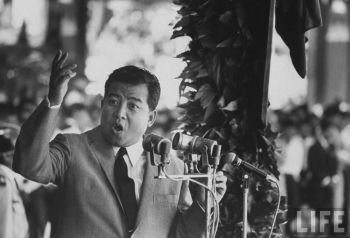 The operational mission of CHERRY was a redundant, three pronged assassination team targeted against Prince Norodon Sihanouk, Cambodia's head of state. Courtesy: images.google.com |
(LOS ANGELES) - Operation Cherry was one of five CIA sponsored activities named after trees. Others included Oak and Pine. As told to me by John McCarthy, a team leader in Cherry, and as posted originally on the web site www.copvcia.com:
(I) McCarthy was the Case Officer in Saigon, of a CIA directed covert operation code named PROJECT CHERRY. The operational mission of CHERRY was a redundant, three pronged assassination team targeted against Prince NORODOM SIHANOUK, the head of state of Cambodia. (It was through this site that I refound John after we both left active duty)(Until just recently, neither John nor I could prove that Cherry was "rogue." In research, Cherry could not be found. Not until late in 2000, after the State Department declassified a section of their records could the trail be traced proving the rogue activities of Cherry. At the time he was involved, John had no knowledge of this rogue activity. His duty was to follow the orders given.)
Although McCarthy was technically a member of the United States Military and Special Forces, his role as Case Officer of PROJECT CHERRY necessitated an elaborate Cover Story as a member of the Department of Defense (DOD) and was covered by identification issued by the United States Embassy in Saigon under an assumed name (John McAlister). This "cover" included absolute directives not to openly associate with any members of our military forces in Vietnam.
PROJECT CHERRY was not a Special Forces mission. This CIA activity employed Special Forces personnel who were selected for their expertise in relevant skills necessary for the conduct of BLACK TERROR and ASSASSINATION missions. The Project was buried deep within a Military Intelligence unit which was itself operating under the guise of a Civic Action Team, a common CIA cover for covert operations world-wide. Although members of the Civic Action team wore various military uniforms and carried on activities as though they were legitimate military officers, some were full time CIA Agents.
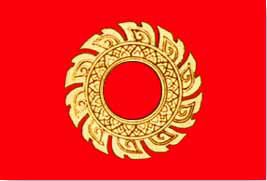 |
The "operational" members of PROJECT CHERRY were Cambodians recruited from the KHMER SEREI, the Government In Exile from Cambodia, violently anti-SIHANOUK and dedicated to the overthrow of the Cambodian Government. The KHMER SEREI was recognized by the Vietnamese Government and operated openly in South Vietnam. PROJECT CHERRY employed twelve members of the KHMER SEREI. Their missions included the conduct of BLACK TERROR against the civilian population of Cambodia, while leaving evidence of their atrocities blaming Cambodian forces for their actions. The purpose of these activities was to create CIVIL UNREST and a rebellion against the Cambodian Regime. It worked. Similar operations utilizing KHMER SEREI were also directed from the United States Embassy in Bangkok, Thailand. PROJECT CHERRY, it turns out, had been compromised by the penetration of an individual who, while holding the rank as the First Secretary of the KHMER SEREI, was the PRINCIPAL AGENT of PROJECT CHERRY and also an Operative Agent of the SOVIET KGB. He was also employed by the SIHANOUK Government at the same time. This information was provided to the United States Embassy in Saigon in February, 1967, by the leader of the KHMER SEREI, SON NGOC THANH. The Americans of PROJECT CHERRY were not notified of this revelation. This triple agent’s name was INCHIN LAM. As Principal Agent, LAM coordinated the activities of the Cambodian members of PROJECT CHERRY and also packed the parachutes used by all team members, including the Americans. Lam was also involved in the murder of one of the Cambodian members of PROJECT CHERRY.
US State Dept. History - Cherry not authorized
To test the authenticity of what John wrote (which of course I believe), let's see what has been written about the subject. By so doing, we will find that Cherry was indeed, rogue, and thereby proving an agency that can hide proof of POWs, drug dealing, and other nefarious schemes with little effort on the part of well placed individuals, if it is so desired.
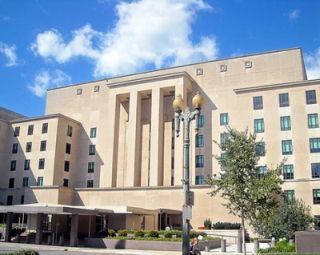 |
U.S. DEPARTMENT OF STATE 95/03/06 Foreign Relations, 1961-63, Vol XXIII, Southeast Asia Office of the Historian
Office of the Historian Bureau of Public Affairs United States Department of State
March 6, 1995 ............
Sihanouk believed the most serious dangers to Cambodia's survival came from Thailand and South Vietnam, rather than from Communist China, the Soviet Union, or even North Vietnam. With the memory of recent plots against him hatched by Cambodian opponents in Thailand and by members of the South Vietnam Government, Sihanouk constantly suspected that his enemies in Bangkok and Saigon were planning his overthrow or his assassination. Because both Thailand and South Vietnam were firmly allied with the United States, Sihanouk believed that those states acted with the full knowledge, support, and approval of their patron. There was little the United States could do to disabuse Sihanouk of this view. (77).....
Allegations of border violations and support for opposition groups and similar issues poisoned regional relations and eventually U.S.-Cambodian relations as well. (95, 100) Regional rivalries were so prevalent that the President's Military Representative, General Maxwell Taylor, concluded in September 1962 that Sihanouk's "morbid fear" of Thailand and South Vietnam had "created a situation of tension and emotionalism which might blow up at any time." (93)
In late 1963, the blow-up occurred. Sihanouk became increasingly agitated by the presence of Cambodian dissidents in Thailand and South Vietnam. By autumn, the issue absorbed him and he fixated on the dissident Khmer Serei, or Free Cambodians, created by his old enemy Son Ngoc Thanh. The Khmer Serei began broadcasting anti-Sihanouk messages into Cambodia from a transmitter thought to be in South Vietnam. Sihanouk publicly and vehemently condemned the group and their broadcasts. Although the Khmer Serei was small in number (about 400) and had no appreciable support within Cambodia, Sihanouk expended an inordinate amount of energy agitating against the group and its radio broadcasts. Sihanouk also raised allegations about U.S. complicity with the group. (108, 109)
Already upset by the Khmer Serei radio broadcasts, Sihanouk was further shaken by the coup in South Vietnam and the assassination of President Ngo Dinh Diem and his brother Ngo Dinh Nhu in Saigon on November 1, 1963. Believing that the United States and the Central Intelligence Agency were behind the coup, Sihanouk saw himself as the next target. His agitation was compounded by the effects of a rigid dietary regimen he had recently begun. The combination made him emotionally overwrought and prone to impulsive, irrational behavior. (108)
Classified records show US policy towards Khmer Serei
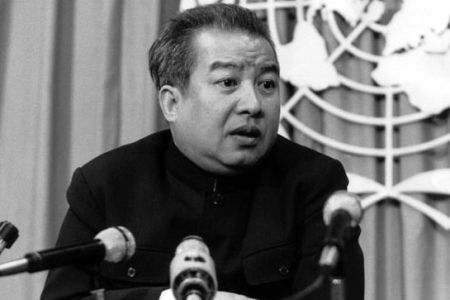 |
Here we see the official record of the State Department is that "Sihanouk also raised allegations about U.S. complicity with the group." Eventually, Sihanouk kicked the U.S. out of Cambodia and the war in Vietnam heated up. There were problems with border areas being used by North Vietnamese forces as sanctuaries. This series of documents show that the U.S. government attempted to get Sihanouk to face up to this reality. It will also show conclusively that Cherry not never mentioned as an operation, even though other Top Secret operations like Daniel Boone are freely referred to. It will also be conclusively shown that contact with the Khmer Serei was not authorized and explicity forbidden by the President.
In December 1965, the year John says Cherry began, the State Department in a Secret message said:
/2/In telegram 1026 to Bangkok, also sent to Saigon as 1708, December 27, the Department expressed concern about Thai and South Vietnamese support for the Khmer Serei. (Ibid., POL 23-8 CAMB)
2. Ambassador Martin should see Prime Minister soonest (and General Praphat as well, if he considers this desirable)/4/ to inform him that we have incontrovertible evidence of activity of Thai officials described above and to request that he take immediate action to terminate any form of RTG support for Khmer Serei. He should use such arguments as he believes best designed to bring about this result but Thanom should be left in no doubt that it is the firm view of the United States Government that Khmer Serei operation will in no way contribute to our broad objectives in Southeast Asia and can only bring discredit on the United States as well as Thailand and South Viet Nam./5/
/5/In telegram 1088 to Bangkok, December 30, Rusk asked Martin also to see Thanom so as to leave no possibility of doubt in Thai minds about the seriousness of U.S. concern in the matter and to make the record completely clear. Rusk stated that he realized "that the Vietnamese are at least equally to blame in this affair and no effort should be spared to bring them to terminate support for the Khmer Serei." (Ibid.)
/7/Lodge reported in telegram 2338 from Saigon, December 31, that should he raise the issue again with Ky, the Vietnamese Prime Minister would ask for a clear view of the U.S. position in Viet Cong use of Cambodia as a sanctuary. Lodge stated that he had "gone as far as I can go on the basis of treating the Khmer Serei as a totally isolated and separate event." (Ibid.) Rusk
CIA told of Khmer Serei no contact
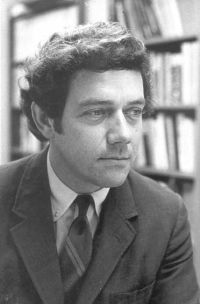 James C. Thomson Jr |
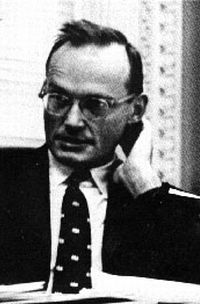 McGeorge Bundy |
Later, in a Secret Memorandum From James C. Thomson, Jr., to the President's Special Assistant for National Security Affairs (Bundy) dated January 5, 1966, it was written concerning Cambodia (it should be pointed out that the US was kicked out of Cambodia because of concern on the part of Sihanouk that the CIA was out to kill him, among other reasons)
(that) "Cambodia is more gravely threatened than ever before--by a pincer movement with MACV on Cambodia's eastern frontier and the Thai/GVN-supported Khmer Serei on the western frontier. Sihanouk is properly scared...." (Note lack of Khmer Serei mention on the RVN frontier)
"Our interests here are two-fold and clear: first and more narrowly, to get the Thai and GVN to call off their dogs--an effort in which we have been so far markedly unsuccessful; ..." (Unsuccessful because some one is convinced that the "secret support" is the "real policy" versus the "public" policy -There is no mention of any US involvement with the Khmer Serei - in fact, all attempts were being made to get Thailand and South Vietnam to quit cooperating with "their dogs")
In a TOP SECRET letter From Acting Secretary of State Ball to Secretary of Defense McNamara dated January 17, 1966 it was stated: “Dear Bob: I have given careful consideration to the problem of Viet Cong use of Cambodia to support its forces in South Vietnam ... agree with your conclusion that, unless there is a sudden and significant increase in the use of Cambodian territory by the PAVN/Viet Cong ... a gradual and cautious response by the U.S. Government and by certain other friendly governments is appropriate and desirable.”
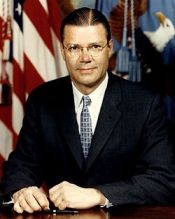 Robert McNamara - 1981 |
Futher, “The following are my thoughts on the Courses of Action proposed by the Joint Chiefs ... The need to expand and intensify the overall intelligence collection ... the paucity of hard evidence on the extent and significance of PAVN/Viet Cong use of Cambodian territory and by the differences in interpretation of available information within the intelligence community ... am forwarding your letter of December 29 to Admiral Raborn, requesting that he ask USIB to re-examine all possible assets to determine additional programs which might be developed to enhance our intelligence capability... the Joint Chiefs envisage ... covert ground cross border intelligence incursions by small teams into Cambodian territory.... make certain that full consideration is given to the political problems ... particularly should there be any question of the use of Vietnamese or 'Khmer Serei' Cambodians....
In conclusion I should like to point out that unsatisfactory as the present situation in Cambodia is from the U.S. point of view, it would be far worse, it seems to me, if Cambodia were pushed into active belligerency against South Vietnam and against U.S. armed forces or if control authority there were to collapse ... as a consequence of border incidents and pressures from such elements as the Khmer Serei movement... I believe that these are dangers which we must always keep in mind..." (ADM Raborn is CIA chief and should know that no one wanted contact with Khmer Serei personnel)
President orders no Khmer Serei contact
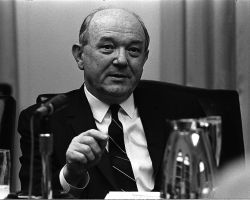 Dean Rusk |
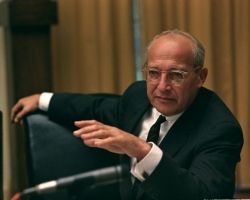 Walt Whitman Rostow |
On June 21 1966, the President's Special Assistant Walt Rostow wrote Secretary Rusk: "In meeting with the NSC staff--urging us all to be imaginative--the President asked for proposals to get closer to Sihanouk. .. The President's enthusiasm is self-evident, including his reaction to pages 5-6." (The President wants to "get closer to Sihanouk")
Continuing,“A. The Problem... some convincing facts of life: 1. The United States is closely associated with Cambodia's two historic enemies, Thailand and Vietnam. ... As long as we are so deeply committed to the Thai and Vietnamese, Sihanouk doubts that we will protect Cambodia's independence... 3. Avoidance of Provocations from Thailand - Despite periodic efforts in Washington and the field, there is still clear evidence of Thai (and Vietnamese) support for the anti-Sihanouk Khmer Serei forces ... The GVN trains Cambodians and ships them to Thailand where they are then put into action on the Cambodia border in order to broadcast anti-Sihanouk appeals and to foment frontier incidents. Sihanouk is still convinced of U.S. collusion with the dissidents. These activities... run counter to our national interests, can only be turned off by a Presidential directive [less than 1 line of source text not declassified] repeated lower level protests have simply not been taken seriously by the GVN or the RTG." (NOTE - SIHANOUK STILL CONVINCED OF US COLLUSION WITH KHMER SEREI - and repeated protests have not been taken seriously by the GVN or the RTG. As McCarthy pointed out, the CIA ran Cherry out of both countries. Note also the description of Khmer Serei activities and what John wrote about. These documents were not declassified until late 2000 -well after what John wrote in 1997.)
Attachment - Memorandum From the President's Special Assistant (Rostow) to President Johnson
Washington, June 20, 1966, 10:30 a.m.
Mr. President:
At your suggestion Jim Thomson has prepared the attached collection of imaginative initiatives with respect to Cambodia. My recommendation is that you instruct me to request Secretary Rusk to examine them and make his recommendations to you--understanding, however, that you wish movement on this problem.
Walt
Approved/2/
Disapproved
See me
/2/Johnson approved and wrote the following note: "This is excellent. I'm proud--L."
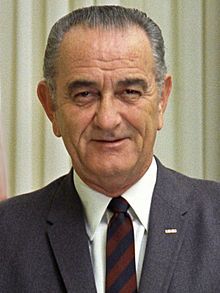 U.S. Pres. Lyndon B. Johnson |
President Johnson ordered his team to not work with the Khmer Serei. To show what Johnson approved, the following was part of the recommendations from the previous: “Problem” C. Recommendations 1. That you indicate to the Department of State the high priority which you attach to an expansion of the ICC in Cambodia./4/ /4/Johnson approved and wrote: "Good & Strong!" 2. That you direct the Department and CIA to press the Thai and Vietnam Governments to cease all support for the Khmer Serei rebels./5/ /5/Johnson approved and wrote: "Same." and drew an arrow to the phrase "Good & Strong!" (original text from State Department Files)
We now have the President of the United States ordering the State Department and CIA to press the Thai and VN Govts to cease all support for the Khmer Serei rebels - Not knowing that CIA is actively working with them. There can be no doubt that President Johnson wanted no cooperation with the Khmer Serei and no doubt that the CIA also knew this. See the follow-up:
185. Memorandum From Acting Secretary of State Ball to President Johnson/1/
Washington, June 29, 1966....SUBJECT Cambodia
1. I refer to the recommendations on Cambodia which you have approved/2/ and indicate below the action that has been and is being taken with respect to each of them. ...2. ... in dealing with Sihanouk, who is Cambodia, we are dealing with someone who is ... proud ... sensitive ... highly mercurial and temperamental....6. Our views on the remaining recommendations are as follows:
A. The Khmer Serei Problem (1) ... when we received intelligence last winter indicative of plans for a build-up of Khmer Serei forces and for large-scale attacks against Northwest Cambodia, Ambassador Lodge in Saigon and Ambassador Martin in Bangkok, acting on Secretary Rusk's personal instructions, made strong representations at the highest level to the governments of South Vietnam and of Thailand to urge an end to support of Khmer Serei activities....
(2) Perhaps more important, we have solid evidence that the Thai, at least, ... are anxious to damp down tensions in the border area.... Sihanouk ... has even talked of finding some means of re-establishing diplomatic relations with Thailand. (3) ... Should there be any indication of a resurgence of Khmer Serei activity or support by the Thais or South Vietnamese, we would then favor again making the strongest possible representations..."
192. Memorandum From the Joint Chiefs of Staff to Secretary of Defense McNamara/1/
SUBJECT Cross-Border Operations (U) ...e. A message from the Defense Intelligence Agency to CINCPAC, DIAAQ 4054/152257Z February 1966, subject: "Clandestine Collection Operations Against Cambodia (S)."/4/
(NOTE _ THE (S) here shows about the subject "Clandestine Collection Operations against Cambodia" that these words together were classified at the Secret Level all by themselves)
...2. (TS) On 13 June 1966, you approved (reference 1a) the recommendation to organize, train, and equip an indigenous force of intelligence agents, reconnaissance teams, and reaction teams for possible future employment in cross-border operations into Cambodia.... 3. (TS) The State Department view (reference 1a)/5/ that the recruitment of ethnic Cambodians (Khmer) should not be permitted was reflected in the guidance provided to CINCPAC by the Joint Chiefs of Staff in reference 1b. However, prior to receipt of this restriction, based on his interpretation of the guidance ... COMUSMACV had already recruited and partially trained 40 ethnic Cambodians. These personnel were carefully screened to ensure that they were not Khmer Serei. ...5. (TS) The State Department's rationale in recommending against the use of Cambodian personnel is as follows: first, the Cambodian minority in Vietnam is strongly influenced by the Khmer Serei (Free Cambodia) movement and second, should Prince Sihanouk learn that a force of Khmers was being formed for cross-border operations into Cambodia, he would interpret this as a serious threat to his regime and be more likely than ever to cast his lot with the Chinese communists. 6. (TS) COMUSMACV's position ... is ... thorough screening, checking and investigation of all Cambodians recruited can minimize penetration of the operation by the Khmer Serei. ... c. All ethnic Cambodians recruited will be carefully screened to reduce the possibility of penetration of the program by Khmer Serei or Cambodian intelligence agents... "
/2/The only suggestion to use Khmer Serei
John McCarthy has already been arrested by the time this next memorandum (Top Secret) is distributed. Nothing is acted upon, and the Khmer Serei will not be used until 1970, after a change of administration takes place. By that time, Cherry is disbanded, John McCarthy is out of jail, appealing his conviction, and the CIA is in the clear - attempting to hide it's previous actions.
219. Memorandum From Marshall Wright of the National Security Council Staff to the President's Special Assistant (Rostow)/1/
Washington, December 12, 1967
SUBJECT
What to do about Cambodia
You asked for an alternative to a military "solution" to the Communist use of Cambodian soil. ...3. Make use of the anti-Sihanouk Khmer Serei elements in South Vietnam and Thailand. There are dangers in this but they are dwarfed by the disadvantages of overt military action against Cambodia. If a rejuvenated Khmer Serei does nothing else, it might convince Sihanouk and others in the Cambodian Government that their own interests lie in trying to minimize Cambodia's availability to the Communists as a sanctuary.
4. Mount a black operation to create in Phnom Penh Rangoon-type riots and demonstrations (ostensibly the work of the Chinese community). Sihanouk has already proved his extreme sensitivity to Chinese misconduct. We would not have to create much of a "Chinese disturbance" to send him up the wall again with all that this would imply for a more vigorous approach by him restrain Communist freedom of action in Cambodia..."
To See open letter to Senators Kyl, Shelby and Attorney General Ashcroft, press here
To learn more about possible CIA felonies in wartime, press here
To learn about covert missions and wartime treason, press here
Source:
Trails Of Deceit By Larry O'Daniel
CIA Rogue Operation Cherry
© Golden Coast Publishing all rights reserved
Reprinted courtesy to Golden Coast Publishing.
 |
 |
 |
 End Israel's Unwarranted Murder of Kids |
Articles for September 9, 2011 | Articles for September 10, 2011 | Articles for September 11, 2011
Salem-News.com:





Terms of Service | Privacy Policy
All comments and messages are approved by people and self promotional links or unacceptable comments are denied.
[Return to Top]
©2025 Salem-News.com. All opinions expressed in this article are those of the author and do not necessarily reflect those of Salem-News.com.